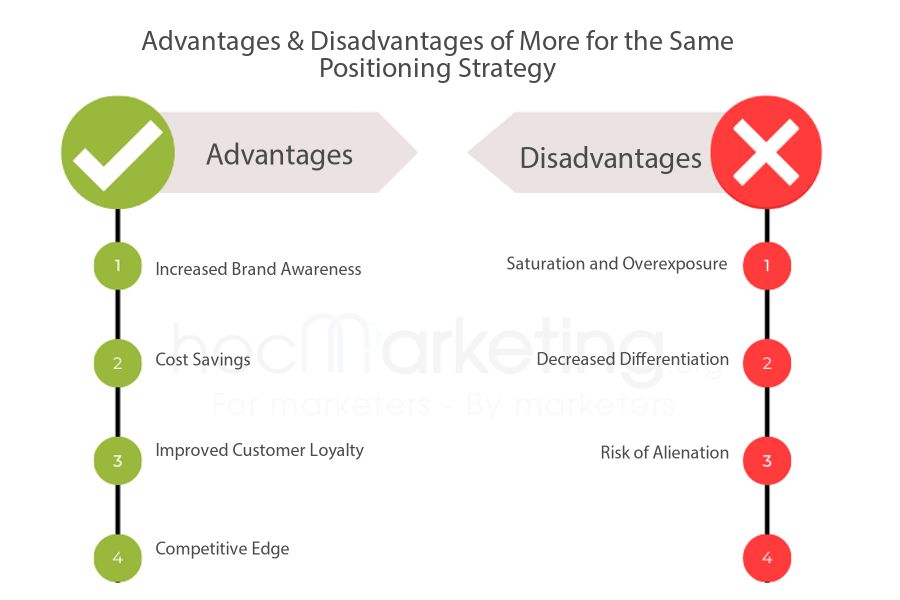
What is More For The Same Positioning Strategy? Advantages and disadvantages

Discover the advantages and disadvantages of adopting a "More for the Same Positioning Strategy" in this insightful article. Learn how it can increase brand awareness, improve customer loyalty, and provide a competitive edge, while also examining the risks of saturation, decreased differentiation, and alienation.
In this blog post, we'll dive into the advantages and disadvantages of this strategy, as well as the factors that businesses need to consider before adopting it. We'll also take a look at some successful case studies of businesses that have implemented this strategy and achieved great results. So, let's get started and explore the world of "More for the Same" positioning strategy!
1. What is More For The Same Positioning Strategy?
More for the same positioning strategy refers to a marketing approach that involves adding more value to an existing product or service without changing its original positioning strategy. This approach aims to enhance the brand's competitive edge by offering more benefits to customers while minimizing costs. More for the same positioning strategy can be achieved through various means, such as increasing the product's quality, offering additional features, or reducing its price. This section will discuss the concept of more for the same positioning strategy and its importance in marketing. The following sections will explore the advantages and disadvantages of this approach and the factors that businesses should consider before adopting it. Additionally, this section will provide some successful case studies that have implemented a more for the same positioning strategy.2. Advantages of More for the Same Positioning Strategy
A more for the same positioning strategy is a marketing approach where a company offers more value to customers without changing the product's price or quality. This strategy has several advantages that companies can leverage to improve their brand's performance. Firstly, adopting a more for the same positioning strategy can increase brand awareness. By offering more value to customers, companies can attract new customers and retain existing ones. This can lead to positive word-of-mouth marketing and increase the brand's visibility.Secondly, a more for the same positioning strategy can result in cost savings. By offering more value without increasing the price or quality of the product, companies can reduce their expenses. This can enable the company to allocate resources to other areas of the business, such as research and development or marketing.
Thirdly, a more for the same positioning strategy can improve customer loyalty. When customers feel that they are getting more value from a brand, they are more likely to remain loyal to that brand. This can increase customer retention rates and ultimately lead to increased revenue.
Lastly, a more for the same positioning strategy can give companies a competitive edge. By offering more value, companies can differentiate themselves from their competitors and attract customers who are looking for more value for their money. This can enable the company to gain market share and increase its profitability.
Overall, adopting a more for the same positioning strategy can have significant advantages for companies. However, it is essential to consider the potential disadvantages and factors that may affect the success of this strategy before implementing it.
Increased Brand Awareness
Adopting a more for the same positioning strategy is a proven way to gain a competitive edge and stay ahead of the competition. One of the main advantages of this strategy is that it can significantly increase brand awareness. By offering more to customers at the same price, companies can attract new customers and retain existing ones, ultimately enhancing their overall brand recognition.When companies offer more for the same price, they are essentially providing customers with more value. This can be in the form of additional features, improved quality, or enhanced customer service. As a result, customers are more likely to remember the brand and recommend it to others, which can help to increase brand awareness both online and offline.
Moreover, when companies offer more for the same price, they can also differentiate themselves from their competitors and create a unique brand identity. This can help to establish a stronger brand image and reputation, which can further boost brand awareness and attract new customers.
Overall, increased brand awareness is one of the key advantages of adopting a more for the same positioning strategy. By providing customers with more value, companies can differentiate themselves from their competitors, enhance their brand recognition, and ultimately drive business growth.
Cost Savings
More for the same positioning strategy can provide cost savings for businesses. By using the same positioning strategy for multiple products or services, companies can save on the cost of developing new marketing and advertising campaigns. They can also save on the cost of market research since they already understand their target audience and what messaging resonates with them.In addition, by leveraging their existing brand equity, companies can save on the cost of building a new brand identity for each new product or service. This can be particularly beneficial for companies with limited resources or smaller marketing budgets.
However, it is important to note that cost savings should not be the only consideration when adopting a more for the same positioning strategy. Other factors such as customer preferences and market trends should also be taken into account to ensure that the strategy is effective and sustainable in the long term.
Improved Customer Loyalty
Improved Customer Loyalty: More for the same positioning strategy can lead to improved customer loyalty as it strengthens the bond between the brand and its customers. By providing more value to customers through additional product features, better customer service, or loyalty programs, companies can increase their customer retention rates and reduce the risk of losing them to competitors. Improved customer loyalty also leads to positive word-of-mouth marketing, which can attract new customers and further increase brand awareness. In the next sub-section, we will explore some successful loyalty programs adopted by companies to improve customer loyalty.Competitive Edge
Having a competitive edge is a crucial aspect of any business, and more for the same positioning strategy can be an effective way to achieve it. By offering more value to customers without increasing costs, companies can differentiate themselves from competitors and gain a competitive edge. This can be achieved through various means such as offering additional benefits, improving product quality, or enhancing customer experience. In this section, we will explore how more for the same positioning strategy can help companies gain a competitive edge and stand out in the market.3. Disadvantages of More for the Same Positioning Strategy
More for the same positioning strategy may bring some disadvantages as well. One of the major drawbacks is the risk of saturation and overexposure. When a brand frequently presents the same message in a similar way, it may become tiresome for the audience, resulting in a decline in interest. This may lead to the brand being perceived as boring or predictable, which could harm its reputation.Another disadvantage of more for the same positioning strategy is decreased differentiation. If a brand repeatedly uses the same approach, it may become difficult for customers to differentiate it from its competitors. This could lead to the brand losing its unique selling point, which may negatively impact its market share and customer loyalty.
Lastly, there is a risk of alienation when a brand uses more for the same positioning strategy. If a brand doesn't adapt to changing customer preferences or industry trends, it may end up alienating its target audience. This could result in a decline in customer loyalty and ultimately impact the brand's revenue and market share.
Therefore, before adopting more for the same positioning strategy, it is essential to consider industry and market trends, customer preferences, and brand image and reputation. These factors can help brands determine whether the strategy is suitable for their target audience and whether it aligns with their overall marketing goals.
Saturation and Overexposure
One of the potential disadvantages of adopting a "More for the Same" positioning strategy is the risk of saturation and overexposure. This occurs when a brand bombards its audience with too much similar content, causing it to lose its impact and appeal. This can lead to customers becoming bored or disengaged with the brand, which can ultimately result in a decline in sales and brand loyalty.Saturation and overexposure can be particularly problematic if a brand is operating in a crowded market or if there are many other brands offering similar products or services. In such cases, it can be difficult for a brand to stand out and differentiate itself from its competitors, leading to a situation where all the brands in the market begin to blend together in the minds of consumers.
To avoid this risk, brands adopting a More for the Same strategy need to be careful to balance consistency with creativity and innovation. They need to ensure that their message remains fresh and relevant, while also staying true to their core values and brand identity. This may require careful market research, testing, and experimentation to find the right balance between familiarity and novelty.
Overall, while saturation and overexposure are potential risks of More for the Same positioning strategies, they can be mitigated by careful planning, execution, and monitoring. With the right approach, brands can leverage the advantages of this strategy while avoiding the pitfalls that can come with it.
Decreased Differentiation
When a company adopts a "More for the Same" positioning strategy, it runs the risk of decreased differentiation. This is because offering more features or benefits without a unique selling proposition can lead to a dilution of the brand's identity. Customers may struggle to distinguish the company's products or services from those of its competitors, leading to a loss of market share.To mitigate this risk, companies need to ensure that their "More for the Same" approach is grounded in a clear value proposition. They need to identify the unique benefits that their products or services offer and communicate these in a way that resonates with their target audience. This may require a deep understanding of customer needs and preferences, as well as ongoing market research to stay ahead of the competition.
Another way to mitigate the risk of decreased differentiation is to focus on product innovation. By continually introducing new and improved products or services, companies can differentiate themselves from their competitors and maintain a competitive edge. This requires a culture of innovation and a willingness to invest in research and development.
Ultimately, the key to avoiding decreased differentiation when adopting a "More for the Same" strategy is to stay true to the company's brand identity and value proposition. By focusing on what makes the brand unique and communicating this effectively to customers, companies can stay relevant and competitive in an increasingly crowded marketplace.
Risk of Alienation
When a company adopts a "more for the same" positioning strategy, there is a risk of alienating its existing customer base. This is because customers who have already purchased the product or service at the original price may feel cheated when they see others getting more for the same price. This can lead to negative reviews, customer churn, and damage to the brand's reputation.To mitigate this risk, companies need to communicate the benefits of the "more for the same" strategy to their existing customers. This can be done through targeted email campaigns, social media posts, or even personalized phone calls. The key is to make sure that existing customers feel valued and appreciated, and understand that the company is simply trying to attract new customers with the offer.
Another way to avoid alienating existing customers is to make the "more for the same" offer available only to new customers. This can be done by running targeted ads or offering coupon codes that are only valid for first-time purchases. By doing so, the company can attract new customers without angering its existing ones.
Ultimately, the risk of alienation can be minimized if the company takes a proactive approach to communication and customer engagement. By keeping customers informed and engaged, the company can build loyalty and trust, and avoid the negative consequences of a poorly executed "more for the same" strategy.
4. Factors to Consider Before Adopting More for the Same Positioning Strategy
Before adopting a "More for the Same" positioning strategy, there are several factors that brands need to consider to ensure its effectiveness. Firstly, it is essential to analyze industry and market trends to determine whether this strategy is suitable for the current market situation. Brands need to research their competitors' strategies and see if they have implemented similar tactics. Additionally, it is necessary to evaluate customer preferences and determine whether they are receptive to more offerings from the same brand. Brands should conduct market research to understand their customers' needs, expectations, and purchasing behavior.Secondly, brands need to evaluate their brand image and reputation before adopting this strategy. If the brand already has a strong reputation and image, implementing a "More for the Same" strategy may strengthen its position further. However, if the brand image is weak, it may not be effective and may even harm the brand's reputation. It is crucial to assess the brand's current position and whether the strategy aligns with its values and objectives.
Lastly, brands need to consider the cost-benefit analysis of implementing this strategy. While this strategy can lead to cost savings, increased customer loyalty, and improved brand awareness, it also comes with risks such as saturation, decreased differentiation, and the possibility of alienating customers. Brands need to weigh the advantages and disadvantages and determine whether the benefits outweigh the risks.
Overall, adopting a "More for the Same" positioning strategy can be a viable option for brands, but it is crucial to consider various factors before implementation. By conducting thorough research and analysis, brands can ensure the effectiveness of this strategy and achieve their desired outcomes.
Industry and Market Trends
Before adopting a more for the same positioning strategy, it is important to consider the current industry and market trends. These trends can provide valuable insights into consumer behavior and preferences, as well as identify potential opportunities and threats. For example, if a particular industry is experiencing a decline in demand, a more for the same strategy may not be the most effective approach. On the other hand, if there is a growing trend towards eco-friendly products, a more for the same strategy that emphasizes sustainability could be highly successful. Understanding the broader market trends can also help companies identify gaps in the market and differentiate themselves from competitors. Ultimately, the success of a more for the same positioning strategy depends on how well it aligns with the current industry and market trends.Customer Preferences
Before adopting a "More for the Same" positioning strategy, it is crucial to consider customer preferences. Understanding what your target audience values and expects from your brand is essential in determining if offering more for the same is a viable option. Conducting market research and gathering customer feedback can provide valuable insights into what customers are looking for in a product or service. For example, a customer survey may reveal that customers value quality over quantity, and therefore, offering more for the same may not be the best strategy to pursue.Additionally, it's important to consider the specific needs and preferences of different customer segments. For instance, younger consumers may be more interested in innovative products, while older customers may prioritize reliability and familiarity. Understanding these nuances can help tailor a "More for the Same" strategy to better resonate with different customer groups.
In summary, customer preferences should be a critical consideration when evaluating whether a "More for the Same" strategy is a viable option. Understanding what your target audience values and expects from your brand can help ensure that any new offerings align with customer needs and preferences.
Brand Image and Reputation
Before adopting a More for the Same Positioning Strategy, it is important to carefully consider the impact it may have on a company's brand image and reputation. A brand's image and reputation are crucial aspects of its identity, and any changes made to its positioning strategy may affect how it is perceived by consumers.One factor to consider is whether the More for the Same approach aligns with the company's existing brand identity. If the company has established itself as a premium brand, for example, adopting a More for the Same strategy may be perceived as a dilution of its brand image. On the other hand, if the company is known for affordability, a More for the Same approach may be well-received by consumers.
Another consideration is the potential impact on customer trust. If a company is seen as constantly changing its positioning strategy, it may create confusion among customers and erode their trust in the brand. It is important to carefully communicate any changes in strategy to customers and ensure that they are aligned with the company's overall brand values and mission.
Overall, a More for the Same Positioning Strategy can be a powerful tool for increasing brand awareness, improving customer loyalty, and gaining a competitive edge. However, it is important to carefully consider the impact it may have on a company's brand image and reputation before adopting this approach.
5. Case Studies of Successful More for the Same Positioning Strategies
In this section, we will explore some successful case studies of companies that have adopted the More for the Same positioning strategy. These companies have effectively leveraged this strategy to increase brand awareness, improve customer loyalty, and gain a competitive edge. By examining these case studies, we can gain insights into how this strategy can be applied to different industries and markets.One example of a successful More for the Same positioning strategy is Starbucks. The coffee giant has consistently expanded its menu offerings beyond just coffee to include food, tea, and other beverages. By doing so, Starbucks has been able to attract a wider customer base and increase their revenue streams. Additionally, Starbucks has created a strong brand image and reputation by emphasizing sustainability, ethical sourcing, and community involvement.
Another example of a successful More for the Same positioning strategy is Apple. The tech giant has consistently released new versions of its products with incremental improvements and updates. By doing so, Apple has been able to maintain its loyal customer base and keep them coming back for more. Apple has also successfully differentiated itself from its competitors by focusing on design, innovation, and user experience.
Lastly, Nike is another example of a successful More for the Same positioning strategy. The athletic apparel company has consistently expanded its product offerings beyond just shoes to include apparel, accessories, and even digital fitness apps. By doing so, Nike has been able to attract a wider customer base and increase their revenue streams. Additionally, Nike has successfully differentiated itself from its competitors by emphasizing its brand values of inspiration, innovation, and inclusivity.
These case studies demonstrate that the More for the Same positioning strategy can be effective in a variety of industries and markets. By focusing on incremental improvements, companies can attract new customers, improve customer loyalty, and differentiate themselves from their competitors. However, it is important for companies to carefully consider their industry and market trends, customer preferences, and brand image before adopting this strategy.
Summary
In conclusion, using the same positioning strategy for an extended period can have both advantages and disadvantages. On the one hand, it can help establish brand recognition and loyalty among customers, leading to increased sales and profits. On the other hand, it can also lead to stagnation and loss of market share as competitors introduce new and innovative products.It is important for businesses to regularly evaluate their positioning strategy and make adjustments as necessary to stay ahead of the competition and meet customer needs. This may involve rebranding, expanding product lines, or exploring new markets.
Ultimately, the success of a positioning strategy depends on a variety of factors, including market conditions, customer preferences, and the ability to adapt to changing trends and technologies. By staying vigilant and flexible, businesses can maximize the benefits of a strong positioning strategy while minimizing the risks of becoming complacent or outdated.















